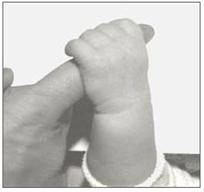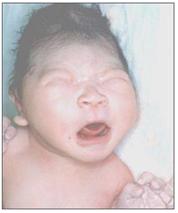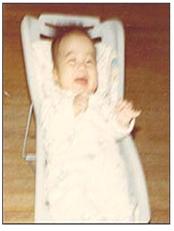생후 29일부터 2개월까지 영아들의 발육, Development of 29th day∼2 month age infants
| 생후 29일부터 2개월까지 영아들의 신체 발육 |
- 몸통의 양쪽을 두 손으로 붙잡고 세워 앉히면 이 나이 영아들의 대부분은 목을 꼿꼿이 가눌 수 없고 목이 흔들거린다.
- 누워 있을 때 주로 태위를 취하는 것이 보통이다(사진 2-260 참조).
| 생후 29일부터 2개월까지 영아들의 손 발육 |
- 신생아기 때보다 손을 더 수의적으로 움직일 수 있다.
- 손을 입 안에 넣고 빠는 것이 보통이다.
- 파악 반사(사진 3-6 참조)가 정상적으로 계속 나타날 수 있다.

사진 3-5. 생후 2개월경 머리를 바닥에서 위로 조금 들어 올릴 수 있다.
Copyright ⓒ 2012 John Sangwon Lee, MD., FAAP

사진 3-6. 파악 반사가 아직도 정상적으로 나타날 수 있다. 엄마의 손가락 등을 파악 반사로 잘 잡을 수 있다.
Copyright ⓒ 2012 John Sangwon Lee, MD., FAAP

사진 3-7.손을 입 안에 자주 넣고 빠는 흡철 반사가 아직 있는 것이 보통이다.
Copyright ⓒ 2012 John Sangwon Lee, MD., FAAP
| 생후 29일부터 2개월까지 영아들의 언어 발육 |
- 확실히 알 수 없는 아기 소리, 즉 옹알옹알 소리를 내어 말하기 시작한다.
- 울어서 감정을 표시하고 몸짓 말로 대화를 한다.
- 음색과 음량이 다르게 울어서 자기의 의사나 요구를 그때그때 표현 한다.

사진 3-8. 갓 태어나서 운다. 울음은 언어이다.
Copyright ⓒ 2012 John Sangwon Lee, MD., FAAP

사진 3-9.영아 산통으로 아파서 울고 있다. 모로 반사로 양팔을 벌렸다.
Copyright ⓒ 2012 John Sangwon Lee, MD., FAAP
| 생후 29일부터 2개월까지 영아들의 사회성 발육 |
- 자신에게 환히 웃는 엄마 아빠나 다른 사람의 얼굴을 보고 따라서 환히 웃고 화답한다.
- 이 나이의 영아들의 눈앞에서 장난감을 흔들어 주면 장난감을 바라볼 수 있다(p.00 시력검사 참조).
- 장난감에서 나는 소리나 엄마의 부드럽고 사랑스런 말소리에 울다가 그칠 수 있다.
( “생후 1개월~6세의 영유아들의 발육 이정표” 참조)

사진3-10. 생후 2개월 된 영아들의 대부분은 엄마 아빠에게 반응해서 웃을 수 있고 생후 2개월에서 5개월까지의 영아들의 대부분은 자발적으로 웃을 수 있다.
Copyright ⓒ 2012 John Sangwon Lee, MD., FAAP

사진 3-11. 생후 1개월 된 영아들의 90% 이상은 엄마 아빠의 얼굴을 쳐다볼 수 있다.
엄마 아빠의 눈길 접촉사랑을 받아 그들의 사랑 탱크 속을 채운다.
Copyright ⓒ 2012 John Sangwon Lee, MD., FAAP

사진3-12. 생후 1개월 된 영아들의 90% 이상은 엄마 아빠의 얼굴을 쳐다볼 수 있고 엄마 아빠의 눈길 접촉사랑을 받아 그들의 사랑 탱크 속을 채운다. 오른쪽 머리부위에 두혈종이 있다. 자연히 낫는다. Copyright ⓒ 2012 John Sangwon Lee, MD., FAAP
| 생후 29일부터 2개월까지 영아들의 영양 |
1. 모유 수유
- 신생아들이나 생후 1~2개월 된 영아들은 하루 8~12번 정도 엄마의 젖을 먹는다.
- 그 중 적어도 한 번은 밤중에 수유하는 것이 보통이다.
- 한 번 잠들면 밤에 4~6시간 동안 내쳐 자는 영아들도 있다.
- 이런 영아들은 낮에 더 자주 먹는 것이 일반적이다.
- 하루 평균 8번 이상 소변을 볼 수 있다.
- 시간제 모유수유를 할 때는 지금부터 3~4시간마다 수유할 수 있고, 하루 6~8번 정도 수유할 수 있다.
- 양 쪽 젖을 수유하는데 평균 15~30분 정도 걸린다.
- 물론 영아에 따라 30~40분 정도, 그보다 더 걸려 또는 덜 걸려 수유할 수 있다.
- 영아가 젖을 먹고 싶어 할 때마다 젖을 주는 방법을 요구수유라고 한다.
- 요구수유로 젖을 줄 때도 약 3~4시간마다 수유하게 된다. 하루 6~8번 정도, 많게는 하루 12번 수유하면 된다.
- 그러나 대부분의 경우, 시간제 모유수유 스케줄만 양육 할 수 없고 요구수유로만 양육 할 수 없다. 절충수유를 하게 된다.
- 영아들이 우는 이유에는 여러 가지가 있다.
- 영아가 울 때마다 모유만 수유해서는 안 된다([부모도 반의사가 되어야 한다-소아가정간호백과]-제 4권 모유, 모유수유, 이유-젖을 얼마나 자주 먹여야 하나 참조).
2. 인공영양(영아 포물라/영아 포뮬라/Infant formula) 먹이기
- 인공영양을 먹일 때는 1회분 90~150cc(3~5온스)를 매 3~4시간마다 하루 6~8번 먹인다.
- 물론 1회분 양과 하루 종일 먹는 총 횟수, 먹이는 간격은 아기의 체질과 먹성에 따라 조절해야 한다.
- 이런저런 이유로 인공영양을 먹이는 데도 식이예술 또는 식이 의술이란 말도 쓴다.
- 참고로 인공영양을 “분유”라고 부르지만 그 말은 적절한 말이 아니고 사실은 인공영양이란 말도 적절한 말이 아니라고 생각한다.
- 영아 포물라, 포물라 또는 포뮬라가 적절한 말인 것 같다.
- 이 시기 영아들에게 이유식을 주어서는 안 된다.
3. 물 과 수분
- 모유나 인공영양의 성분의 85~87%가 물이다.
- 따라서 모유나 인공영양을 주로 먹는 영아들에게 특별한 경우를 제외하고 물을 따로 더 먹일 필요는 없다.
- 그러나 여름철이나 날씨가 무더운 날이나 실내의 온도가 상당히 높을 때는 모유나 인공영양을 먹인 후 맹물을 우유병으로 먹일 수 있다.
- 끓여서 식힌 맹물이나 보리차물을 숟가락으로 떠먹일 수 있다.
- 물을 많이 먹이면 모유 섭취량이나 인공영양 섭취량이 줄 수 있다.
- 모유만 수유하는 영아들에게 철분과 비타민을 별도로 꼭 줄 필요가 없으나 철분제와 비타민 A, C, D가 든 종합비타민제를 처방에 따라 하루 이틀 간격으로 생후 4~6개월까지 주어도 좋다.
- 생후 3개월까지 우유병과 젖병 꼭지는 가능한 한 살균소독해서 다시 쓰는 것이 좋다.
표 3-2. 소아청소년의 나이와 체중에 따른 1일 필요 수분 평균량
| 나이 | 체중(Kg) | 하루에 필요로 하는 평균 수분 량(ml/Kg) |
| 3일 | 3.0 | 80~100 |
| 10일 | 3.2 | 100~150 |
| 3개월 | 5.5 | 140~160 |
| 1세 | 9.5 | 120~140 |
| 6세 | 20.0 | 90~100 |
| 12세 | 88.0 | 60~80 |
| 성인 | 70.0 | 20~40 |
Development of 29th day∼2 month age infants
Physical development of infants from 29 days to 2 months of age
• Most infants this age cannot keep their necks upright and their necks shake when they are seated upright with both hands on the torso.
• It is normal to take the position mainly when lying down (see picture 2-260).
Hand development in infants from 29 days to 2 months of age
• Can move hands more voluntarily than in newborns.
• It is common to put your hand in his or her mouth and suck.
• The grasp reflex (see photo 3-6) may continue to appear normally.

Photo 3-5. Around 2 months of age, they can lift their head slightly upwards from the floor. Copyright ⓒ 2012 John Sangwon Lee, MD., FAAP

Photo 3-6. The grasp reflex may still appear normally. It is possible to grasp the mother’s fingers and the like by grasping reflex. Copyright ⓒ 2012 John Sangwon Lee, MD., FAAP

Photo 3-7. It is common to still have the suction reflex of frequently putting his or her hand in his or her mouth and sucking it. Copyright ⓒ 2012 John Sangwon Lee, MD., FAAP
Language development in infants from 29 days to 2 months of age
• Begins to speak with an indistinguishable baby sound, a babbling sound.
• Cry to express emotions and communicate with body language.
• Cry with different tones and volumes to express one’s wishes or needs from time to time.

Picture 3-8. newborn crying Crying is a language. Copyright ⓒ 2012 John Sangwon Lee, MD., FAAP

Photo 3-9. The infant is crying because of colic. The infant spreads his or her arms out in the Moro reflex. Copyright ⓒ 2012 John Sangwon Lee, MD., FAAP
Social development of infants from 29 days to 2 months of age
• See the faces of moms, dads, or other people who smile brightly at him or her and respond with a big smile.
• Infants of this age can look at the toy by shaking it in front of their eyes (see Vision Test).
• You may stop crying at the sound of toys or your mother’s soft, loving words. (See “Milestones in the development of infants and toddlers aged 1 month to 6 years old”)

Picture 3-10. Most 2-month-old infants are able to laugh in response to their mother and father, and most infants from 2 months to 5 months are able to laugh spontaneously. Copyright ⓒ 2012 John Sangwon Lee, MD., FAAP

Photo 3-11. More than 90% of 1-month-old infants can look into their mother’s and father’s faces. They fill the tank of their love by receiving the love of the eyes of their mothers and fathers. Copyright ⓒ 2012 John Sangwon Lee, MD., FAAP

Picture 3-12. More than 90% of 1-month-old infants can look into their mother’s and father’s faces and fill their love tanks with the love of their mother’s and fathers’ eye contact. There is a hematoma on the right side of the head. get better naturally Copyright ⓒ 2012 John Sangwon Lee, MD., FAAP
Nutrition for infants from 29 days to 2 months of age
1. Breastfeeding
• Newborns and infants 1 to 2 months old drink their mother’s milk 8 to 12 times a day.
• It is common to breastfeed at least once during the night.
• Some infants sleep for 4 to 6 hours a night once they fall asleep.
• It is common for these infants to eat more frequently during the day.
• They can urinate more than 8 times a day on average.
• If you are part-time breastfeeding, you can breastfeed every 3 to 4 hours from now on, and you can feed 6 to 8 times a day.
• It takes an average of 15-30 minutes to breastfeed both breasts.
• Of course, depending on the infant, breastfeeding may take 30-40 minutes, more or less.
• A method of giving milk whenever an infant wants to breastfeed is called demand feeding.
• Even if you are breastfeeding as a demand feeding, you will breastfeed about every 3 to 4 hours. Feed 6 to 8 times a day, up to 12 times a day.
• However, in most cases, it is not possible to support only schedule-time breastfeeding schedules and not only on-demand breastfeeding. You will have compromised breastfeeding.
• There are many reasons why infants cry.
• Breastfeeding should not be the only option whenever an infant cries (see www.drleepediatrics.com-Volume 4 Breastfeeding, Breastfeeding, Weaning – How Often to Breastfeed). 2. Feeding artificial nutrition (infant formula/infant formula / Infant formula)
• When feeding artificial nutrition, feed 90~150cc (3~5oz) per serving every 3~4 hours 6~8 times a day.
• Of course, the amount of one serving, the total number of meals throughout the day, and the feeding interval should be adjusted according to the baby’s constitution and eating habits.
• For various reasons, artificial nutrition is also referred to as dietary art or dietary medicine.
• For reference, artificial nutrition is called “milk formula”, but I don’t think it’s an appropriate term, and actually, artificial nutrition is not an appropriate term.
• Infant formula, formula or formula seems appropriate.
• Weaning food should not be given to infants at this time.
3. Water and Moisture
• 85-87% of the ingredients of breast milk or artificial nutrition are water.
• Therefore, it is not necessary to provide additional water to infants who are mainly breastfed or fed artificial nutrition, except in special cases.
• However, in summer, on a hot day, or when the indoor temperature is very high, you can feed milk or artificial nutrition and then drink fresh water from a bottle.
• You can eat boiled and cooled freshwater or barley tea with a spoon.
• Drinking a lot of water can reduce breast milk intake or artificial nutrition intake.
• It is not necessary to separately give iron and vitamins to infants who are only breastfed, but it is possible to give iron and multivitamins containing vitamins A, C, and D every day or two according to the prescription, up to 4-6 months of age.
• Until 3 months of age, it is recommended to sterilize and reuse milk bottles and bottle nipples as much as possible.
Table 3-2. The average amount of water needed per day according to age and weight of children and adolescents
표 3-2. 소아청소년의 나이와 체중에 따른 1일 필요 수분 평균량
| Age | Weight(Kg) | Average amount of water needed per day(ml/Kg) |
| 3 days | 3.0 | 80~100 |
| 10 days | 3.2 | 100~150 |
| 3 months | 5.5 | 140~160 |
| 1 year | 9.5 | 120~140 |
| 6 years | 20.0 | 90~100 |
| 12 years | 88.0 | 60~80 |
| Adult | 70.0 | 20~40 |
출처 및 참조문헌
- Nelson Textbook of Pediatrics 22ND Ed
- The Harriet Lane Handbook 22ND Ed
- Growth and development of the children
- www.drleepediatrics.com 제1권 소아청소년 응급 의료
- www.drleepediatrics.com 제2권 소아청소년 예방
- www.drleepediatrics.com 제3권 소아청소년 성장 발육 육아
- www.drleepediatrics.com 제4권 모유,모유수유, 이유
- www.drleepediatrics.com 제5권 인공영양, 우유, 이유식, 비타민, 미네랄, 단백질, 탄수화물, 지방
- www.drleepediatrics.com 제6권 신생아 성장 발육 육아 질병
- www.drleepediatrics.com제7권 소아청소년 감염병
- www.drleepediatrics.com제8권 소아청소년 호흡기 질환
- www.drleepediatrics.com제9권 소아청소년 소화기 질환
- www.drleepediatrics.com제10권. 소아청소년 신장 비뇨 생식기 질환
- www.drleepediatrics.com제11권. 소아청소년 심장 혈관계 질환
- www.drleepediatrics.com제12권. 소아청소년 신경 정신 질환, 행동 수면 문제
- www.drleepediatrics.com제13권. 소아청소년 혈액, 림프, 종양 질환
- www.drleepediatrics.com제14권. 소아청소년 내분비, 유전, 염색체, 대사, 희귀병
- www.drleepediatrics.com제15권. 소아청소년 알레르기, 자가 면역질환
- www.drleepediatrics.com제16권. 소아청소년 정형외과 질환
- www.drleepediatrics.com제17권. 소아청소년 피부 질환
- www.drleepediatrics.com제18권. 소아청소년 이비인후(귀 코 인두 후두) 질환
- www.drleepediatrics.com제19권. 소아청소년 안과 (눈)질환
- www.drleepediatrics.com 제20권 소아청소년 이 (치아)질환
- www.drleepediatrics.com 제21권 소아청소년 가정 학교 간호
- www.drleepediatrics.com 제22권 아들 딸 이렇게 사랑해 키우세요
- www.drleepediatrics.com 제23권 사춘기 아이들의 성장 발육 질병
- www.drleepediatrics.com 제24권 소아청소년 성교육
- www.drleepediatrics.com 제25권 임신, 분만, 출산, 신생아 돌보기
- Red book 29th-31st edition 2021
- Nelson Text Book of Pediatrics 19th- 21st Edition
- The Johns Hopkins Hospital, The Harriet Lane Handbook, 22nd edition
- 응급환자관리 정담미디어
-
소아가정간호백과–부모도 반의사가 되어야 한다, 이상원
-
Neonatal Resuscitation American heart Association
-
Neonatology Jeffrey J.Pomerance, C. Joan Richardson
-
Pediatric Resuscitation Pediatric Clinics of North America, Stephen M. Schexnayder, M.D.
-
Pediatric Critical Care, Pediatric Clinics of North America, James P. Orlowski, M.D.
-
Preparation for Birth. Beverly Savage and Dianna Smith
-
Infectious disease of children, Saul Krugman, Samuel L Katz, Ann A. Gershon, Catherine Wilfert
- 소아과학 대한교과서
- Growth and Development of Children, Eighth Edition, George H. Lowrey, Yearbook Medical Publishers
- Growth and Development of Children, Fifth Edition, E. H. Watson and G. H. Lowrey, Yearbook Medical Publishers
- Other
-
Copyright ⓒ 2015 John Sangwon Lee, MD., FAAP
미국 소아과 전문의, 한국 소아청소년과 전문의 이상원 저 “부모도 반의사가 되어야 한다”-내용은 여러분들의 의사로부터 얻은 정보와 진료를 대신할 수 없습니다.
“The information contained in this publication should not be used as a substitute for the medical care and advice of your doctor. There may be variations in treatment that your doctor may recommend based on individual facts and circumstances. “Parental education is the best medicine.”